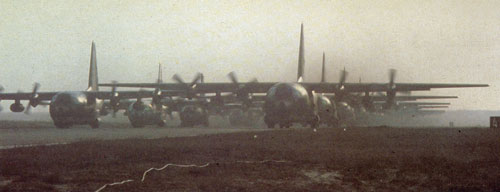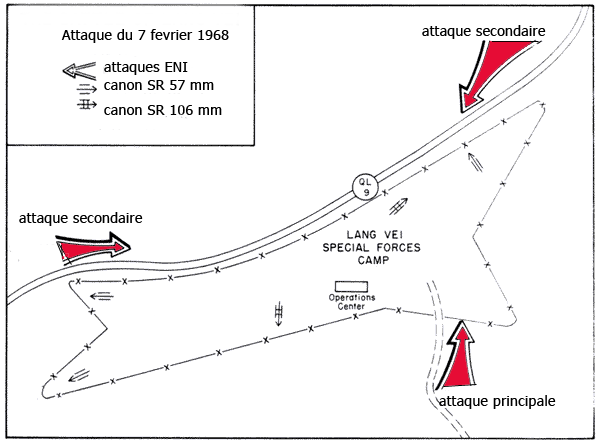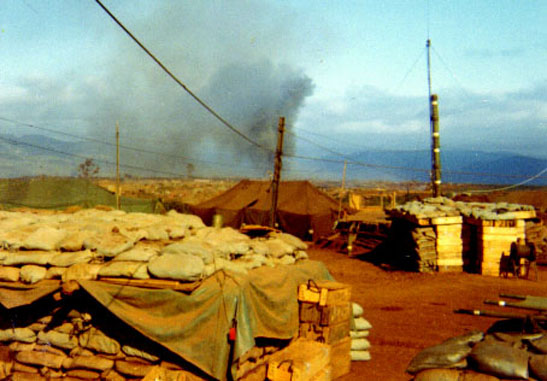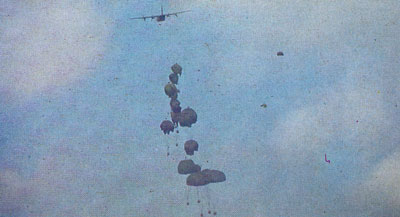The 77 days of Khe Shan Seat
French Version Claude Balmefrezol
traductionJL Trouillon
.gif) |
| Medal of Honnour |
If a number of wars have engendered traumas in the so-called civilized societies, the Vietnam War engendered a deep trauma throughout the United States. As much as the Algerian War for France, the Afghan War for Russia, the Vietnam War engendered a deep trauma in this country which had for several decades served as a world leader.
Origins of the vietnam War
The Vietnam peninsula was conquered by the French in the late 19th century. Defeated by Prussia in Europe the French would, during the Thrid Republic, found an empire that would rival with the British Empire, thus taking their revenge following the 1870 Franco Prussian War. This expansion would forge men and troops that, together with her allies, offered France a victory over Germany. The future leaders of world War I did learn their business in the colonies. Gallieni and Joffre in Madagascar, Lyautey and Mangin in Africa. To return to Vietnam, this territory was conquered in the latter years of the 19th century
In the aftermath of our defeat in Europe in 1940 the Japanese occupied the country and tried to rally all Asian peoples under their banner : Asia for Asians.
In 1945, after the defeat of Germany and Japan, French troops were sent to reestablish the authority of the mother country. That was the task of Leclerc's Second Armoured Division. This intervention reinforced a deep bitterness and a partition of the country followed. If the South of the country, with Saigon, was rather in favour of the presence of the colonial power the North, led by the communist Ho Chi Minh, declared its independence in September 1945. The communists won the following elections and they demanded an immediate withdrawal of the French troops. The War of Indochina, that was to last until 1953 had just begun for France. It ended with the defeat of Dien Bien Phu. The French troops withdrew, leaving the two rivals facing one another. The 1954 Geneva agreements included the partition of the country along the 54th parallel. The South was armed and supported by the West but its political situation was appalling. As it tried to control that region political situation was appalling. As it tried to control that region the United States was to be drawn into the war.
The Geneva agreements were quite clear. There coud not be another conflict in the region. An international commission including India, Canada and Poland was set up to verify the implementation of the agreements.
The « resignation » of that commission was followed by an ever increasing involvement of the United States. The situation on the ground was rather confuse. According to the terms of the agreement the French had withdrawn from Indochina. However a number of partisans of the communist regime remained, obeying an order given by Ho Chi Minh who feared the presence of the French troops.
These « partisans » were to become the backbone of the future Viet Cong.
In the South the influence of the emperor Bao Dai, sentenced to exile,was fought by General Diem.
In Laos struggle for influence between the partisans of each side was at the origin of the civil war between the government and the Pathet Lao in 1960.
At that time the situation in Cambodia was different from that of the other countries of the peninsula. Prince Norodom Sihanouk took the title of king, party leader and head of state. The situation was to turn into a nightmare twenty years later.
AMERICAN INTERVENTION
The JFK era
.jpg) |
| 1917 1963 |
In the Indochinese peninsula this explosive situation, in the context of the Cold War that had reached a breaking point, saw the confrontation of the United States and its allies against the North Vietnamese supported by the Chinese and the Soviets.
The election of Kennedy to the Presidency of the United States led to an involvement of the country. In 1961 Vice-President Lyndon B. Johnson was sent into South East Asia: his mission was to reaffirm the American support to President Diem, to evaluate the needs of the governments and then to draft a precise report to help the President have a clear idea of the situation.
The VP's idea was very clear. It was necessary to send in more troops. On the other hand President Diem wanted nothing but military equipment. It was then decided to provide the equipment that would allow the Vietnamese army to increase its size up to 30,000 men as well as the creation of a 60,000 man strong guard.
American advisors were sent to train this force. President Diem refused the idea of any compromise on the question of human rights and freedoms. The mandarins had to remain in power against all odds. When he read his VP's report President Kennedy concluded, in complete agreement with his advisers, that American troops had to be sent to Vietnam for a number of reasons: on the one hand prove the reality of the American involvement in the Far East following the Laos question, and on the other hand support the Vietnamese armed forces in their fight against the communist troops. At first, within the framework of M.A.C.V (Military Assistance Command Vietnam) which had taken the place of M.A.A.G (Military Assistance Advisory Group) special forces as well as air units and reconnaissance groups were sent. For JFK, champion of the free world, these special forces better known as Green Berets whose motto is De Oppresso Liber (i.e. Free the oppressed) were quite capable of fighting and defeating the communist troops that had infiltrated the South. More than 5,000 men were to serve in these somewhat special troops. However, the atypical character of their missions shut them off from the other American forces not to mention the South Vietnamese ones. In 1962 Robert MacNamara announced to JFK that all was going according to plan and that the ARVN (Army of the Republic of Vietnam) was counting its successes. However it should be kept in mind that during that period the Diem regime was never trusted by the South Vietnamese as the reforms that had been promised had not arrived. In a climate of general corruption the morale of the population balanced between anger and apathy.
In America the media opposed the Diem regime by showing its dirty face.
On the ground, the Ap Loc battle which saw the death of three Americans definitely descredited the Diem regime in the eyes of the Americans. Diem had to be driven out of power to prevent the press from influencing the Congress against any prorogation of help.
The pretext came soon. There was in this country a struggle for influence between the catholic minority supported by Diem and the Buddhist majority. An incident at Hue degenerated, the army intervened and a dozen people were killed.
During the whole of the 1063 Summer incidents kept occurring between the two communities. TheWhite House decided to intervene after a number of bonzes had set themselves on fire. A last attempt was made to change President Diem followed by a coup. On 1 November 1963 President Deim was overthrown by army officers led by Guong Van Minh better known as Big Minh. Deim and his brother committed suicide.
However JFK would not take advantage of this new situation as he was assassinated in Dallas on 22 November 1963.
.jpg) |
| 1908 1973 |
The Lyndon B. Johnson era
(1).jpg) |
| Westmorland (left) internet |
A new period was to open under the Johnson presidency, that of the massive American intervention. Vietnam's new strongman, «Big Minh » soon met with the hostility of his fellow citizens. Nothing changed, corruption developed and a new coup saw the arrival of Nguyen Kanh. The military situation worsened rapidly. Communist incursions incrased and a new aid of $60 million was granted to the country. The situation became critical in July. It was therefore decided to bomb North Vietnam. General Cao Khy, in charge of the South Veitnamese Air Force was strongly in favour of this measure. However on 2 August 1964 a new incident would give the USA a pretext to intervene directly in the conflict. That day, the MADDOX, an American battleship, was attacked in the Tonkin international waters by North Vietnamese launches replying to a raid launched by the South Vietnamese forces 300 km to the north of the demilitrized zone. 4 August saw another naval engagement. As a repraisal the Navy bombarded the North Vietnamese harbours and on 7 August communist forces started moving towards the demilitarized zone. On 11 August a resolution adopted by the US Congress reaffirmed its support to South Vietnam, including the use of combattant American troops. The document had been dradfted so as not to constitute a declaration of war which would have drawn the USSR and China into the conflict. In this preelectoral period the President moved cautiously. Once the elections over things began to change. Between the Bay of Tonkin Incident in 1964 and the 1968 Tet offensive the conflict would demand an ever increasing American engagement. The major facts of that period were for South Vietnam on the political level a new coup in 1965 which saw the rise to power of Nguyen Cao Ky and the failure of political reforms; on the military level there was an increase of the military forces, an intensification of american bombings over North Vietnam and an ever increasing engagement of American ground forces
Let us now consider our subject, i.e.
This episode took place during the Tet offensive in January-February 1968 and until March 1968
The Tet offensive
.jpg) |
| Vietcong Flag |
The major puropose of that offensive was to attack deliberately the urban and military centers of South Vietnam. The communist forces intended to destroy the South Vietnamese military forces and to rally the local population to their cause. Some 140,000 assailants were to attack 36 of the 44 regional capitals ans 5 of the 6 autonomous cities.
The operations can be divided into three major axes of effort between 31 January and 23 February: the attack of Hue which caused high losses in the population, that of Hoa and that of Tan Son Nhut. The communists also brought war inside Saigon with the attack of the US embassy, a highly symbolic place. These attacks were not conclusive: first of all it was a military failure as the South Vietnamese forces quickly resumed the offense once the firs moment of surprise was surpassed. The populationsdid not rally to the revolutionary ideas. The South forces proved their efficacy and strengthened the idea of the « Vietnamisation of the war » i.e. a progressive withdrawal of the Americans
The seat
.gif) |
The Khe San base was in the north west of the former South Vietnam, 10km from the Laos border. Because of its situation to the south of the demilitarized zone it threatened the right flank of the Ho Chi Minh trail. A camp of the Green Berets had been set up there as early as 1962. Between that date and 1966 the camp suffered regular artillery strikes. In January 1967 the special forces were relieved by the 3rd Marines. This unit moved the camp and built a landing strip. Once the works over the 26th Marines set up there. The new garrison immediately started to improve the fortifications of the camp. However they were met with a serious problem i.e. The impossibility for heavy carriers to land on the strip. To solve this difficulty the Americans set up a system which is still used nowadays. As the heavy carriers were unable to land it was decided to parachute the equipment. But the nature of the terrain was such that much was lost in the swamps. It was therefore decided to deliver the equipment
through palette extraction. This technique has since then been improved and French troops still use it to perfection. As a reservist I took part in exercises which allowed me to
watch the efficiency of the BOMAP guys or those of the RLA that used to be in Metz and now in Toulouse. To be successful the loads to be delivered are first palettised and equiped with parachutes. Once the palettes ready they are fed inside the plane. When arriving on the zonee th aircraft moves closer to the ground as if it was going to land. At the last moment, a few feet above the ground the pilot elevates the plane to take off again and presses on the throttle. The paymaster then delivers the first palette. Due simply to their weight the loads exit the plane and slip to the ground, slowed by their parachutes. Heavy loads, even ligh-armoured vehicles, can be delivered to their users.
 |
| Low altitude parachutism extraction system |
In Khe San, thanks to that technique, the strip was made somehow accessible to the heavy carriers. Surrounded by hills, with a river flowing in the middle, the base was almost a reminder of Dien Bien Phu. The climatic conditions, with a heavy fog lifting only in the late morning hours, complicated the task of the defenders.
By late 1967 military intelligence mentioned the presence of two communist divisions around Khe San, a communist officer was made prisoner and spoke of an imminent attack on the base.
The Khe San base
.jpg) |
| Khe Shan |
The battle began on 21 October 1968 with the attack of an outpost. At the end of the ground action the communist artillery entered into action destroying, among others, the
ammo depot (1,360 tons) and damaging the landing strip severely. The 26th Marines withdrew within the perimeter of the camp, most civilians were evacuated to Da Nang by helicopter
.jpg) |
 |
| Wrecks of CH 53 |
C130 |
The Sea Bees started working but were unable to repair the strip, the heavy carriers were not capable of landing safely. In the meantime the Tet offensive was launched all over the country and Khe San remained in a vise.
Facing other problems the American command decided that the base was to be resupplied and defended by air.
Facing 5,000 GIs and their allies were two communist divisions, the 320th and the 325th, 18,000 men strong. However the communists suffered from a new weapon, electronic sensors, the Americans had launched on
.jpg) |
.jpg) |
to all the axes of advance and of communication as well as around the base.
These « weapons » had been on trial just before the Tet offense. They got a real life test during that battle. The helicopter was a major asset for the troops tasked for this job were not able to penetrate enemy territory deeply. The helicopter allowed the transportation of teams deep into enemy territory and also the creation of security belts around the defensive perimeter. As an illustration, the sensors warned of an abnormal activity around a mountain overhanging the base. Thanks to this information American intelligence deduced that an attack would take place in this area (hill 881). On 5 February at dawn a deluge of fire fell on the vicinity of the hill. There was no attack. On 7 February the communists attacked the special forces camp to the West of Khe San with PT76 tanks. Owing to the strength of the enemy the camp was abandoned and the survivors retired to Khe San. The effort of the North Vietnamese troops was brought to the entranched camp itself. On 9 February the defensive perimeter was attacked.
.gif) |
 |
In spite of an intense pounding (54,000 tons of napalm) around the camp the communist forces managed to set up a number of surface to air and field artillery pieces. That was to cause the loss of resupply aricraft: 6 planes and 17 helicopters were thus lost. To counter this threat the crews proposed a simple tactics resting on the planes' flat floors: as soon as the aircraft touched the ground and taxied down at slow speed the paymaster released the palettes, the pilot pressed dowh the throttle and the palettes were extracted out of the plane which was ready to take off within 30 seconds after landing.
During the whole month of February the Marines suffered intense boardments from the communist forces (an average of 1,000 shells), to which ground attacks on outposts have to be added. To fight the enemy efficiently Colonel Lowndshad the idea to tell his men that the communists were digging tunnels in order to surge suddenly in the middle of the base. To counter this danger he set up anti-ferret teams which drove into the ground pickets equiped with stethoscopes all around the base. However the topography of the site – a plateau sourrounded by deep thalwegs – would not allow the communist forces to dig tunnels, just well-camouflaged galleries of approach.
.jpg) |
.jpg) |
| Cote 881 |
Rock Pile |
Together with this trench warfare was a sniper warfare. In both camps snipers were kept busy. An anecdote: a communist marksman was able to wound fifteen Americans before being betrayed by the sun. The problem was solved by a 106 recoilless gun!
On 29 February a massive assault was launched against the camp. Betrayed by the electronic sensorss it was stopped in its tracks by a massive air intervention (an air bombing can « clean » 100 acres in a single strike) and an aritllery barrage. Towards 15 March American military intelligence confirmed that communist troops were withdrawing from Khe San. On 1 April Plan Pegasus was implemented to relieve the garrison. On 1 April the roads were no longer blocked. On 14 April the siege was officially over and the communist troops were retiring.
.jpg) |
 |
General Giap and his HQ acknowledged the fact that a new Dien Bien Phu was made impossible by the progress of technology. As long as the Americans would support the South Vietnamese forces no decisive battle could be won. The American side realized that it was impossible to breach the morale and aggressiveness of the communist troops. The only possible solution lay in negociation
CONCLUSION.
This war was at the origin of a serious trauma in the American society and the population doubted its destiny for a time. It was not until the Reagan era that America recovered its assurance thus allowing it to claim the rôle of World Leadership (for better or for worse). This rôle was reinforced by the disintegration of the Soviet Bloc.
USA/ARVN
9th Marines Rgt (1 bat)
26th Marines Rgt (3 bats)
37th Rangers Rgt (ARVN
3 105 mm batteries
1 155 mm battery
1 107 mm mortar battery
18 175 mm pieces
TOTAL 46 pieces
10 SR 106 mm howitzers
6 90 mm tank guns
2 AA M42 tanks with 40 mm guns
2 M55 with 50 calibre guns
AIR SUPPORT
REVIEW
11,276 tons of supply dropped
99,700 tons of bombs dropped
Losses
6 planes and 17 helicopters
Human losses
199 killed
1,600 wounded
2MIA
AVN/VIET CONG
304th division
325th division
TOTAL 20,000 men
152 mm and 13 mm pieces
PT 76 tanks
Mortars ans MLRs
Losses
2 AA guns
207 heavy weapons
557 weapons
17 vehicles (including PT 76 tanks)
Human losses
199 killed
1500/10,000 killed






.gif)
(1).jpg)
(1).jpg)
.jpg)
.jpg)
.jpg)
(1).jpg)
.gif)
.jpg)
.gif)

.jpg)
.jpg)


.jpg)
.jpg)
.gif)

.jpg)
.jpg)
.jpg)
